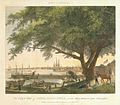| Ulmus americana 'Penn Treaty' | |
|---|---|
 Scion of the Penn Treaty Elm at the Haverford College Arboretum, planted 1915 (2017) | |
| Species | Ulmus americana |
| Cultivar | 'Penn Treaty' |
| Origin | Penn Treaty Park, Kensington, Philadelphia, US |
The American elm cultivar Ulmus americana 'Penn Treaty' was raised by the Plant Sciences Data Center of the American Horticultural Society. Plants under that name were propagated by the Morris Arboretum, Pennsylvania, Philadelphia, from grafts made in 1945 from a tree at Haverford College, itself a graft, planted in 1840, from the Shackamaxon Treaty Elm – the tree under which William Penn signed his treaty with Native Americans in 1682 [1] (felled by a storm in 1810 [2] ) in what was later named Penn Treaty Park, Kensington, Pa. [3]
